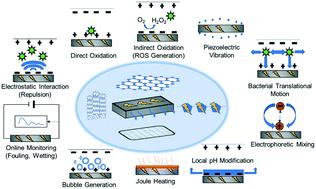当前位置:
X-MOL 学术
›
Environ. Sci.: Water Res. Technol.
›
论文详情
Our official English website, www.x-mol.net, welcomes your
feedback! (Note: you will need to create a separate account there.)
Synthesis, fabrication, and mechanism of action of electrically conductive membranes: a review
Environmental Science: Water Research & Technology ( IF 3.5 ) Pub Date : 2021-3-5 , DOI: 10.1039/d0ew01070g Najmul Haque Barbhuiya 1, 2, 3, 4 , Utkarsh Misra 2, 3, 4, 5 , Swatantra P. Singh 1, 2, 3, 4, 5
Environmental Science: Water Research & Technology ( IF 3.5 ) Pub Date : 2021-3-5 , DOI: 10.1039/d0ew01070g Najmul Haque Barbhuiya 1, 2, 3, 4 , Utkarsh Misra 2, 3, 4, 5 , Swatantra P. Singh 1, 2, 3, 4, 5
Affiliation

|
Membrane technology has been used in desalination and wastewater treatment due to its many advantages such as ease of operation, smaller footprint, higher efficiency, and lower chemical consumption over conventional technologies. However, there are still some challenges associated with membrane technology, viz. fouling, selectivity to uncharged contaminants in pressure-driven membranes, and energy consumption without compromising the water quality. These necessitate the need for new generation membranes with better selectivity with antifouling capability. Advancements in the field of materials science and membrane preparation processes are giving new possibilities for mitigating these problems of conventional membrane filtration with the use of electroconductive membranes or ECMs. ECMs combine the separation effect of the membrane with the electrical effects of the conducting elements. Over the last few years, ECMs have been applied using different conductive elements such as graphene, conductive polymers, carbon nanotubes (CNTs), etc. ECMs is a rapidly growing field, and they have shown potential for desalination and wastewater treatment. Therefore, there is a need for an updated review focusing on the different aspects of ECMs. Moreover, there is a lack of reviews on ECM synthesis and fabrication, application, and action of mechanism in the broad range of membrane filtration, such as pressure-driven, thermal driven, and osmotically driven membrane processes. Thus, this review is focused on the synthesis and fabrication of ECMs, conductive elements used, and antifouling mechanisms of ECMs under positive, negative, and alternate biases. The important ECM studies so far conducted in commonly used pressure-driven membrane processes, along with the recent advancements made in the field of FO and MD using ECM have also been reviewed. Moreover, this review provided the current status of the energy and cost aspects of ECMs along with the current challenges and possible future development paths for the ECMs.
中文翻译:

导电膜的合成,制备及作用机理的综述
膜技术由于具有许多优点,例如与传统技术相比,具有操作简便,占地面积小,效率高和化学物质消耗少等优点,已被用于海水淡化和废水处理中。然而,膜技术仍然存在一些挑战,即。污垢,对压力驱动膜中不带电污染物的选择性以及能耗,而不会影响水质。这些使得需要具有更好的选择性和防污能力的新一代膜。材料科学和膜制备工艺领域的进步为缓解使用导电膜或ECM的常规膜过滤的这些问题提供了新的可能性。ECM将膜的分离作用与导电元件的电作用结合在一起。在过去的几年中,已使用不同的导电元素(例如石墨烯,导电聚合物,碳纳米管(CNT)等)来应用ECM 。ECM是一个快速发展的领域,它们已经显示出了脱盐和废水处理的潜力。因此,需要针对ECM的不同方面进行更新的审查。此外,在广泛的膜过滤(例如压力驱动,热驱动和渗透驱动的膜工艺)中,对于ECM的合成,制备,应用以及机理的作用尚缺乏评论。因此,本综述着重于ECM的合成和制造,所使用的导电元件以及在正,负和交替偏压下的ECM的防污机理。迄今为止,在常用的压力驱动膜工艺中进行的重要ECM研究以及使用ECM在FO和MD领域中取得的最新进展也得到了综述。而且,
更新日期:2021-03-11
中文翻译:

导电膜的合成,制备及作用机理的综述
膜技术由于具有许多优点,例如与传统技术相比,具有操作简便,占地面积小,效率高和化学物质消耗少等优点,已被用于海水淡化和废水处理中。然而,膜技术仍然存在一些挑战,即。污垢,对压力驱动膜中不带电污染物的选择性以及能耗,而不会影响水质。这些使得需要具有更好的选择性和防污能力的新一代膜。材料科学和膜制备工艺领域的进步为缓解使用导电膜或ECM的常规膜过滤的这些问题提供了新的可能性。ECM将膜的分离作用与导电元件的电作用结合在一起。在过去的几年中,已使用不同的导电元素(例如石墨烯,导电聚合物,碳纳米管(CNT)等)来应用ECM 。ECM是一个快速发展的领域,它们已经显示出了脱盐和废水处理的潜力。因此,需要针对ECM的不同方面进行更新的审查。此外,在广泛的膜过滤(例如压力驱动,热驱动和渗透驱动的膜工艺)中,对于ECM的合成,制备,应用以及机理的作用尚缺乏评论。因此,本综述着重于ECM的合成和制造,所使用的导电元件以及在正,负和交替偏压下的ECM的防污机理。迄今为止,在常用的压力驱动膜工艺中进行的重要ECM研究以及使用ECM在FO和MD领域中取得的最新进展也得到了综述。而且,











































 京公网安备 11010802027423号
京公网安备 11010802027423号